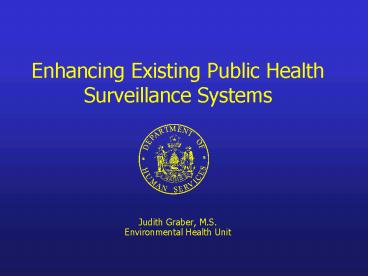Enhancing Existing Public Health Surveillance Systems - PowerPoint PPT Presentation
1 / 20
Title:
Enhancing Existing Public Health Surveillance Systems
Description:
Provide educational opportunities about the hazards of environmental lead. Monitor the prevalence of lead poisoning. Maine Bureau of Health Environmental Health Unit ... – PowerPoint PPT presentation
Number of Views:59
Avg rating:3.0/5.0
Title: Enhancing Existing Public Health Surveillance Systems
1
Enhancing Existing Public Health Surveillance
Systems
- Judith Graber, M.S.
- Environmental Health Unit
2
Enhancing Existing PH Surveillance
Systems Rationale
- National Goals for an EPHTS
- Incorporate non-infectious diseases into a
national public health surveillance system. - Identify program and policy needs.
- Bridge the gap between environmental protection
and public health data and programs.
3
Enhancing Existing PH Surveillance
Systems Approach
- Select programs
- Conduct joint assessments
- Develop priorities
- Implement by providing technical assistance and
support - Context Build capacity at all levels
4
Enhancing Existing Surveillance Systems Resources
- Federal funds
- Technical capacity
- Planning Consortium
- Environmental context
- Data Collection
- Data Analysis
- Database Analyst
- Risk Communication
- Clinical
- Env. Epidemiologist
- Surv. Epidemiologist
- Toxicologists
- P. Hlth. Physician
- Comp. Health Planner
5
Enhancing Existing PH Surveillance
Systems Selecting Programs
- In Process
- Asthma Prevention and Control Program
- Childhood Lead poisoning and Prevention Program
- Maine Cancer Registry
- Others?
6
Enhancing Existing PH Surveillance
Systems Presentation
- Program description
- Relevant Program Goals
- Collaborative Enhancements
7
Status Asthma Prevention and Control Program
- Program description
- Program was created by legislative mandate March
2002 - National direction to address
- Relationship with environmental factors
- Occupational asthma
- Budget 350,000 (100 federal)
- Staff Count 2
8
Status Asthma Prevention and Control Program
- Relevant Program Goals
- Identify gaps and needs in data and surveillance
for asthma - Developed and maintaining a statewide
surveillance system for childhood and adult
asthma - Occupational asthma
9
Status Asthma Prevention and Control Program
- Collaborative Enhancements
- Develop joint strategy for surveillance of
occupational asthma - Fund Asthma ED diagnosis validation study
- BRFSS questions
- Assess usefulness
- Pay for
10
Status Childhood Lead Poisoning Prevention
Program
- Program description
- Service and population-based functions
- Supported by legislative mandate
- Budget 416,975 (72 Federal 28 State)
- Staff Count 4
11
Status Childhood Lead Poisoning Prevention
Program
- Relevant Program Goals
- To reduce the prevalence of elevated BLLs
- Promote appropriate screening
- Provide educational opportunities about the
hazards of environmental lead - Monitor the prevalence of lead poisoning
12
Status Childhood Lead Poisoning Prevention
Program
- Collaborative Enhancements
- Consult on PAMS development
- Database assistance
- Geographical analysis of at-risk population with
screening tests and results - Potential linkage with environmental databases
13
Status Maine Cancer Registry
- Program description
- Statewide population-based cancer surveillance
system - Legislatively mandated reporting all newly
diagnosed or treated cancer - Budget 482,916 (68 Federal 32 State)
- Staff Count 7 Employees
14
Status Maine Cancer Registry
- Relevant Program Goals
- Reduce the morbidity and mortality due to cancer
by providing data for research and intervention
programs - Provide data for the planning and evaluation of
cancer prevention and control programs - Respond to concerns about local cancer rates
15
Status Maine Cancer Registry
- Collaborative Enhancements
- Incorporate environmental health into long term
plan - Geocoding of data
- Provide technical support
- Potential Spatial analysis
- Plan to assess usefulness occ./industry fields
16
Next Steps
- Continue ongoing work and prioritize future
activities - Evaluate other programs
- Genetics
- Pregnancy Risk Assessment Monitoring System
(PRAMS) - Comprehensive Cancer Planning
- Cardiovascular Disease Program
- Other?
17
(No Transcript)
18
Number of Children lt 6 Years of Age By Census
Tract - Maine, 2000
19
Pre-1950 Housing by Census Tract - Maine, 2000
20
Estimated Number of Children lt 6 Years Living in
Pre-1950 Housing Maine, Census 2000































